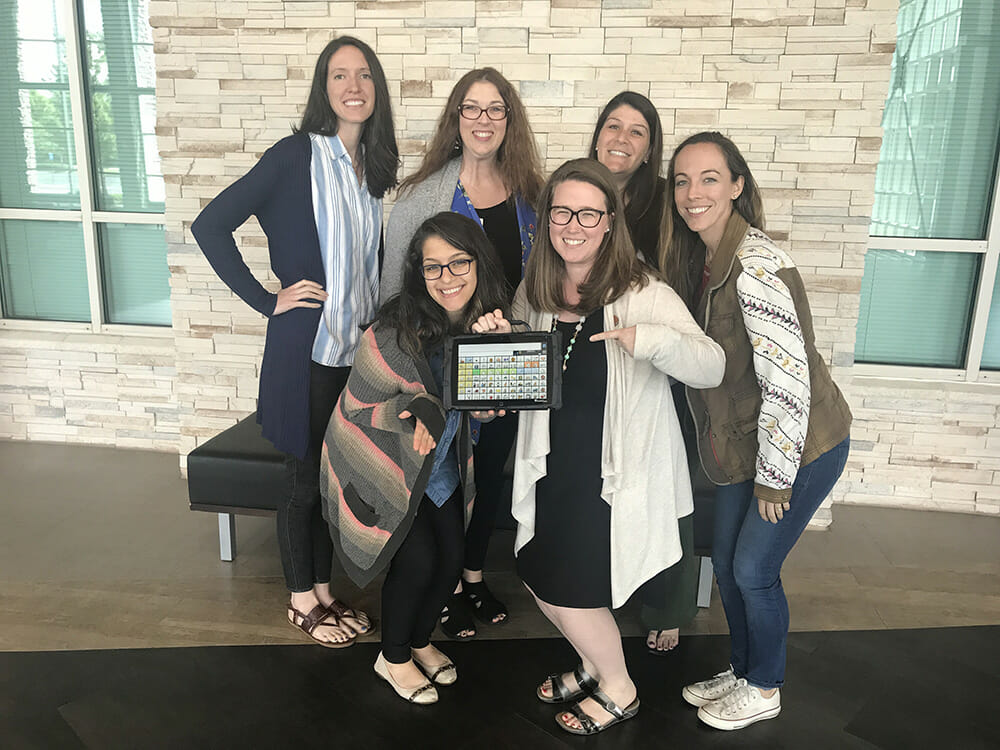Kid’s Creek Therapy recently hosted the LAMP conference, an event where SLPs, OTs, teachers, paraprofessionals, ABA therapists, and parents gathered to learn more about the LAMP approach to augmentative alternative communication (AAC). All of our SLPs, in addition to one of our OTs, attended the conference and were trained on the LAMP principles. In today’s blog post, Jessica Orlick explains LAMP and shares what our team learned.
Is your child nonverbal?
Have you ever wondered if your child’s verbal output could be expanded?
Have you ever wondered if your child could benefit from a Speech Generating Device (SGD)?
Language is at the core of everything we do.
How do we understand what someone is saying to us? How do we let someone know what we want? How do we learn how to do a task? Learning language on an AAC/SGD is like learning a new language. There is a need for consistent modeling and instruction across activities and environments (“Language Immersion”) and everyone involved from the client, parents/family, school team, therapy team, etc., needs to be on board. Imagine going to work and everyone spoke German – you were the only one speaking English. If nobody tried to learn English or even provide you with a translator, how isolated would you feel? How motivated would you be to try any task/learn any concept?
There are many ways a Speech-Language Pathologist can help a child develop language, but in some cases a Speech Generating Device (SGD) is an additional tool that can be used to help a child communicate.
What is LAMP?
LAMP is an acronym for Language Acquisition through Motor Planning and is a therapeutic approach based on neurological and motor learning principles. LAMP strives to improve language and communication by imitating the neurological processes associated with typical speech development, and pairing a consistent motor movement with consistent auditory feedback and a natural response while using a SGD. These principles can be used with ANY speech generating device. The LAMP principles were based on the clinical work of John Halloran, MS, CCC-SLP, Cindy Halloran, OTR/L (husband and wife duo), and Mia Emerson, MS, CCC-SLP. While interacting with nonverbal children with autism, these clinicians noted that:
– Giving individuals access to core words on a speech-generating device,
– Teaching those words in sensory-rich activities, and
– Accessing each word on the device with a consistent, unique motor pattern with auditory feedback
provided a means for developing independent communication.
There are five components to LAMP1:
- Readiness to Learn: arousal state, difficulty level of the activity, visual/auditory attention to the task
- Joint Engagement: activities should be intrinsically rewarding– moment of JOY!
- Consistent and Unique Motor Plans: using consistent and unique motor patterns to activate vocabulary on an SGD leads to automaticity – decreased cognitive motor plan when time to speak
- Auditory Signals: consistent auditory output/additional sensory info to enhance language learning
- Natural Consequences: no matter what word the child selects on the AAC, respond naturally
At the LAMP workshop, our therapists were trained in the principles of LAMP, as well as on the specific software language of LAMP Words For Life (WFL). Prentke Romich Company (PRC) offers multiple devices that use LAMP WFL. My personal favorite component of WFL vs. other speech generating device languages is the fact that any word on the device uses a NO MORE THAN THREE touches before you access the word. THREE! I have worked with kiddos that use other languages and it has taken me up to seventeen touches to find a word – by the time I found the word, I completely forgot what I was going to say about it! A maximum of three touches and it is the exact same motor pathway each and every time you go to access it. Can you imagine having to go a different way to get to the freezer to get ice cream every time? After a while, the joy of eating ice cream is paired with the hassle it takes to get there and you give up. But if you were able to get there the exact same way, each and every time you wanted to, AND you were able to do so quickly??? Well, you wouldn’t mind taking the 3 steps to get there since you knew it would always be there, right?
My second favorite component to LAMP WFL is the fact that it is not only for nonverbal kiddos. I recently went through the certification process for LAMP (yes, that is how much I LOVE these principles!!) and did so working with a 17 year old child that is verbal, but has a limited vocabulary. In the three months I worked with her directly applying these principles and trialing on a device with WFL (only once a week), she made significant improvements! Her spontaneous verbal speech went from an average of 1-2 word phrases to 3-4 word phrases, her motivation to participate in therapy sessions increased, and her confidence to communicate improved! In her case, the SGD is being used to supplement her verbal output. The beauty of SGDs and LAMP WFL is not a mold that the child needs to fit into, but rather the child gets to mold how the SGD is most beneficial for them!
Please reach out to any of our SLPs with questions regarding Speech Generating Devices and/or LAMP Words For Life.
Jessica Orlick, MS, CCC-SLP
1(Andrews-Parrill, Teresa, June 2018, AAC Strategies for Promoting the Development of Communication for Individuals with Autism Spectrum Disorder, Presented at LAMP: Language Acquisition through Motor Planning)
Further Resources:
LAMP Words for Life
Prentke Romich Company








